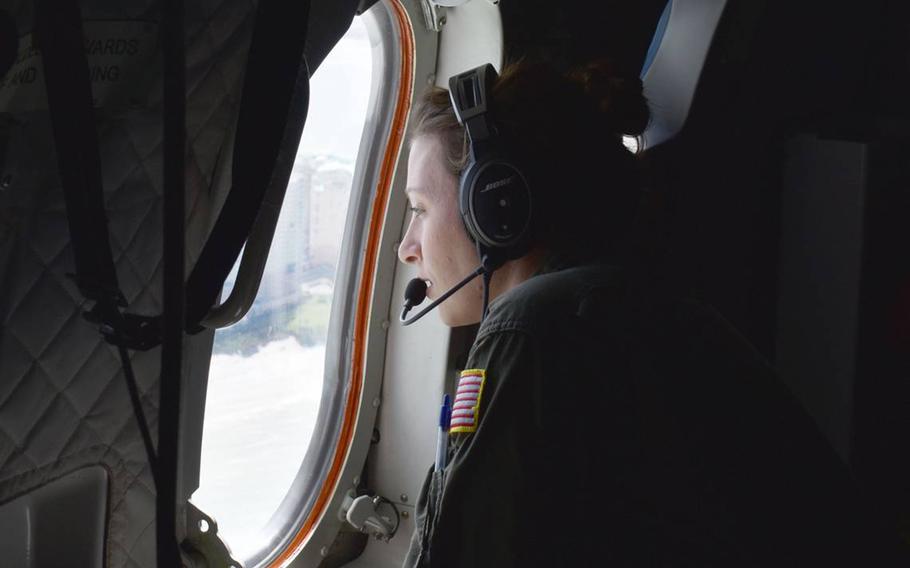
A Coast Guard flight crew member looks out the window as she’s positioned to watch for any danger on a flight to Southwest Florida on Sunday, Oct. 2, 2022. (Grethel Aguila/Miami Herald/TNS)
(Tribune News Service) — From thousands of feet in the air, it's easy to see the extent of Hurricane Ian's destruction on Florida's Gulf Coast.
It's an eerie feeling. The region resembled a ghost town.
Not a resident was visible on the streets. Only police, fire rescue and ambulances navigated the area as they searched for survivors.
Debris from houses, condos, businesses and resorts was piled up. Palm trees were scattered on beaches. Boats — and even homes — were capsized in bodies of water. All were similar sights in Fort Myers Beach, Sanibel and Captiva.
Inside a Coast Guard HC-144 Ocean Sentry, Air Station Miami personnel peered out the windows, each positioned to watch for any danger from other aircraft in the area. Headphones canceled out the engine noise and tuned into the pilots' banter and damage commentary. Coast Guard units from all over Florida and the Southeast are participating in search-and-rescue missions along Hurricane Ian's destructive path.
When conducting a search and rescue mission, service members are dedicated to locating anyone in the area being surveyed, said Lt. Cmdr. Brandon DeCardenas, who piloted the Sunday afternoon flight that included a Miami Herald reporter.
"Our job, during Ian, has been to spot those people, locate those people and then get ... a helicopter on scene to hoist those people out," he said.
Almost 650 people have been rescued by Coast Guard units, according to data provided by Air Station Miami. There have been more than 150 flight missions, which have rescued 261 people and 75 pets.
The Coast Guard's flood water rescue teams have located an additional 380 people and 19 pets and also transported seven loads of supplies and 60 first responders to areas in need.
On the first flight DeCardenas piloted, which took place right after Ian, the crew stayed aloft over the scene for seven hours. Most subsequent flights have been three to five hours.
And there are challenges. Visibility was poor in the days following Ian, DeCardenas said.
"Conditions fluctuate for every single case, which is something big that we have to deal with..." DeCardenas said. "(We need) to make sure we're taking off to meet all of our restrictions and regulations but also to take off safely and come back safely."
Through the storm, dozens of service members responded to the latest forecast updates at a makeshift command center at Opa-locka airport, where their aircraft are based. Normally, the command center is at the Coast Guard Seventh District headquarters downtown. Now, they've shifted their efforts on responding to rescue missions, still working from the airport office on Sunday.
Service members received additional training to be equipped to respond. A classroom of pilots on Monday before Ian's arrival participated in urban search and rescue training. They went through scenarios that were likely to arise in Ian's aftermath.
These training sessions weren't taking place just because of Ian. The Coast Guard prepares service members throughout the year to ensure they can adequately fly and respond to a storm, Lt. Cmdr. Karl Alejandre said then.
"We (are ready to) respond however we are requested," Alejandre said. "It could be that there's flooding in an area, and we're providing an overflight assessment. It could be taking search-and-rescue support people and equipment."
©2022 Miami Herald.
Visit at miamiherald.com.
Distributed by Tribune Content Agency, LLC.